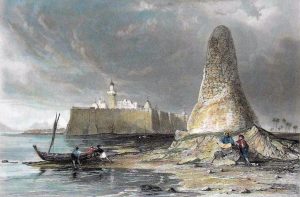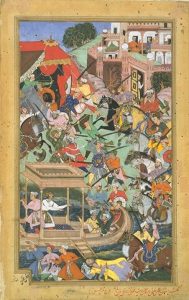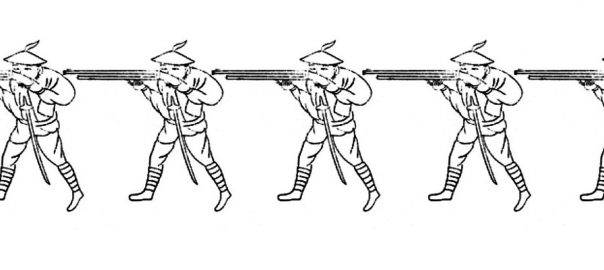Well, lots of things happening in 1560 CE. Today’s survey will take us to many of that era’s empires!
Here we go:
- Spain’s king Philip II had assembled a coalition of Christian naval powers with the goal of retaking Tripoli, in today’s Libya, from the Ottomans, who had captured it in 1551. The Christian fleet, totaling around 200 ships, assembled in Messina (Italy)and traveled via Malta to Tripoli, with more than 10,000 soldiers on board. In late February 1560, they briefly made landfall near Tripoli but were soon forced by bad weather and a lack of water to fall back to the island of Djerba, off the south-eastern coast of today’s Tunisia. That location they were easily able to over-run, and they set about fortifying it…
-

19th century engraving of the Pyramid of Skulls, Djerba But an Ottoman fleet was already on its way from Istanbul. It arrived at Djerba on 11 May, effecting complete strategic surprise of the island’s Christian defenders. The Battle of Djerba lasted only a few hours, resulting in a stunning Ottoman victory. About half the Christian galleys were captured or sunk. Christian casualties were estimated between 9,000 and 18,000. A few Christians were able to hole up in their newly completed fort but they lasted only three months. English-WP tells us: “The victory in the Battle of Djerba represented the apex of Ottoman naval domination in the Mediterranean, which had been growing since the victory at the Battle of Preveza 22 years earlier. Of particular importance were the crippling losses of the Spanish fleet in experienced personnel: 600 skilled mariners (oficiales) and 2,400 arquebusier marines were lost, men who could not be quickly replaced… The victorious Ottomans erected a pyramid of skulls of the defeated Spanish defenders, which stood until the late nineteenth century.”
- The England-France-Scotland triangle started off the year messy but soon got resolved. In January, some French forces who were on the east coast of Scotland were trying to fight against Protestant Scottish “Lords of the Congregation” but then those Scottish lords did a deal under which the English came in to help them expel the French. In July, the three powers signed the Treaty of Edinburgh under which the French agreed to leave Scotland. The Treaty also ended many centuries of war between England and Scotland.
- In August, the Scottish parliament adopted a Protestant confession of faith.
-

Painting of the killing of Bairam by a brigand, from the Akbarnama Over in the Mughal Empire, young Emperor Akbar had now turned 18. He also turned against the faithful Vizier, Bairam Khan who had (a) helped Akbar’s father Humayun regain his empire and (b) been Akbar’s regent since Akbar had become emperor aged 14, four years earlier. The English-WP entries on both men don’t reveal what the cause of the disagreement was. But we do learn that Bairam’s wife was Salima Sultan Begum, who was a cousin of Akbar’s– and that after Bairam’s death, Akbar married her. Suspicious, huh? As to how/why Bariram died, he had had a falling-out with Akbar, who ordered him into exile in Mecca. But on the way there he was killed. All very murky. However, Akbar now had to take a lot more responsibility for running this big empire.
- In the Ming Empire, Qi Jiguang, the military innovator whom we met last year, published a military manual called the “Jixiao Xinshu.” Building on the experience he’d acquired training the Ming soldiery along the coast, the manual gave detailed descriptions of the best order and the best use of military formations of a variety of sizes including a description of a volley-fire technique for the newly-introduced muskets. (Above, see part of the ‘firearm squad’ he designed.)
- Two other notable innovations in 1560 that would gain more impact over the decades that followed were: (1) the start of more significant attacks against Spanish loot-convoys sailing from the Caribbean Basin, launched by French and other-nation pirates and the government-sanctioned pirates known as privateers; and (2) the apparent first introduction of tulip bulbs to the Netherlands, from Constantinople.
